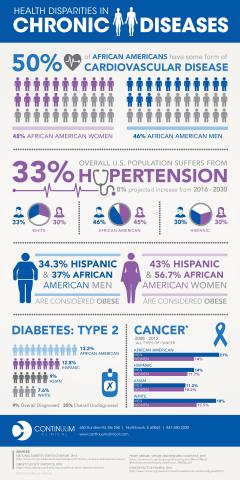NORTHBROOK, Ill.--(BUSINESS WIRE)--Before the middle of this century, one out of every two Americans will be a person of color or a person of color who speaks Spanish, according to U.S. Census Bureau projections. This fact takes on special significance since the FDA declared 2016 the “Year of Diversity in Clinical Trials.”
Continuum Clinical, a healthcare research and communications company that works with pharmaceutical companies to market and recruit patients for clinical trials, together with leading multicultural marketing expert Sheila Thorne, president and CEO of Multicultural Healthcare Marketing Group, have created a new infographic that they hope will help to illustrate further the importance of increasing diversity in clinical trials.
“With Americans living much longer, healthier lives due to better preventative care, technology and improved access to healthcare,” says Sheila Thorne, “there is renewed urgency to make sure that people of color not only have increased access to care, but also have increased representation in pharmaceutical clinical trials.”
Last year Continuum partnered with Sheila Thorne/MHMG to help pharmaceutical companies recruit more diverse patient populations, especially for certain disease states that disproportionately affect people of color.
Minority participation in clinical trials in the U.S. has a troubled history, dating back to the Tuskegee Experiments nearly 83 years ago in which the U.S. Public Health Service allowed 399 black men with syphilis go without the benefit of penicillin therapy.
“This chapter in our history only partly explains why African Americans remain reluctant to participate in clinical trials,” states Thorne. “But there are cultural differences beyond this, such as how people of color utilize healthcare services, medications and even talk about health.”
According to the FDA, African Americans comprise 14% of the U.S. population, but only 5% of clinical trial participants. As the infographic illustrates, African Americans account for a disproportionately high number of cases of cardiovascular disease and hypertension. Similarly, Hispanic/Latinos comprise 17% of the U.S. population, but less than 1% of clinical trial participants. Yet the infographic shows that diseases such as obesity and Type 2 diabetes disproportionately affect Hispanic populations.
“At a time where it is becoming increasingly difficult for pharmaceutical companies to achieve their patient recruitment goals, we have found that connecting with and engaging patients from diverse ethnic groups is a key element of a successful communications plan,” said Ken Shore, Executive Vice President of Continuum Clinical. “Each patient population requires its own strategy and appropriate tactics for it to be successful, however.”
In 2014, the FDA released a report that called for, among other things, “identifying barriers to subgroup enrollment in clinical trials and employing strategies to encourage greater participation,” that was specifically aimed at underrepresented ethnic populations and women. The FDA reported its progress earlier last year, including “education/training for reviewers about demographic inclusion, analysis, and communication of clinical data.” However, the industry has continued to face challenges in adjusting to the FDA recommendations to encourage wider participation among minority populations.
Continuum Clinical and Thorne’s strategy takes the FDA’s recommendations to heart by creating recruitment materials that are ethnically relevant, and that go beyond simply inserting pictures of people of color on brochures. They also utilize community influencers and grassroots campaigns in unlikely places within ethnic communities.
“We actually get boots on the ground within communities and reach influencers that many people wouldn’t think of in white communities,” says Thorne. “These include religious leaders, popular community restaurants and businesses; truly reaching out to people within ethnic communities that have clout to get the word out about a diabetes or kidney disease clinical trial.”
The Continuum Clinical and MHMG teams are hopeful that this approach will help to close the gap in healthcare disparities. Or at the very least help Americans to understand that “minority health” is really going to be “American health” in the not-too-distant future.
About Continuum Clinical
Continuum Clinical is a global healthcare research and communications company. With over thirty years of experience, Continuum Clinical brings together a unique blend of world-class experience in key disciplines, including post-approval research, marketing, communications, health economics, and outcomes research. We excel in providing seamless resources for pharmaceutical and biotech products — from patient recruitment and retention for clinical trials to late stage studies and health economics and outcomes research, as well as medical communications. Continuum Clinical provides a unique blend of resources and perspectives, proven expertise, and innovative solutions throughout the entire continuum of a product’s lifecycle — from pre-launch into the real world. Headquartered in the US, Continuum Clinical has employees in Europe and expanded worldwide network of resources.
About Multicultural Healthcare Marketing Group
MHMG is a full-service market research and marketing communications company with a team of seasoned, in-culture and in-language professionals with in-depth knowledge and experience in the public and private sectors of the healthcare industry. MHMG is committed to setting the gold standard of “best practices” in marketing health information to communities of color and to the healthcare professionals who treat them – focused on the business case of eliminating racial and ethnic health disparities.




